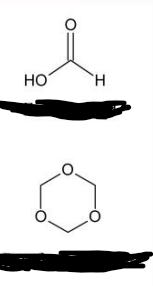Anti infectives 4.1
1/140
Earn XP
Description and Tags
Did not include alcohols and cationic surfactants, gi tapul kog input hehe
Name | Mastery | Learn | Test | Matching | Spaced |
|---|
No study sessions yet.
141 Terms
Joseph Lister (in 1867)
He introduced antiseptic principles for surgery and post traumatic injury
Phenol (Carbolic Acid)
He used ____________ (__________) as a wash for the hands, as a spray on an incision site, andonbandages applied to wounds. Lister’s principles caused a dramatic decrease in the incidenceof postsurgical infections
Paul Erlich
The father of chemotherapy
Selective toxicity
The property of certain chemicals to destroy one form of live without harming another, was the cornerstone of modern antimicrobial chemotherapy
Robert Koch
Paul Erlich was a disciple of ______________
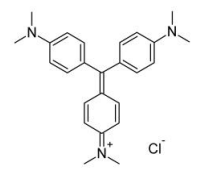
Gerntian violet
Name the chemical
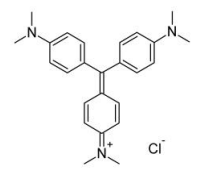
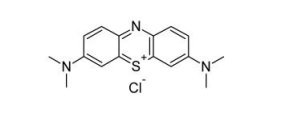
Methylene blue
Name the chemical
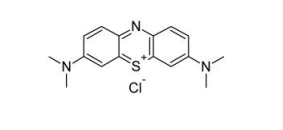
Selective toxicity
The main tenet of modern antimicrobial chemotherapy
sulfonamides and penicillins
Ehrlich’s seminal discovery paved the way for the development of the ___________ and __________ and the elucidation of the mechanisms of selective toxicity.
Cinchona
Herbal remedy for malaria
Ipecac
herbal remedy for amebic dysentery
Salvarsan
Ehrlich’s discovery of compound 606, the effective anti syphilitic drug ______________, was a breakthrough in the treatment of a serious, previously untreatable disease.
Group IIB-Mercury
Group VA - Arsenic & Antimony
Until the 1920s, most successful anti-infective agents were based on the group-___ element ____ and the group-___elements ________ and _________.
Atoxyl (Sodium arsanilate and arsphenamine)
______________(______________________) was used for sleeping sickness
Trypanosomiasis
This is a vector-borne parasitic disease caused by protozoans, transmitted by bites of tse tse flies (glossina)

Atoxyl
Name the compound

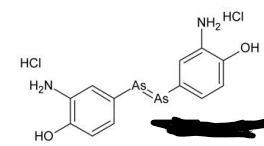
Arsphenamine
Name the compound
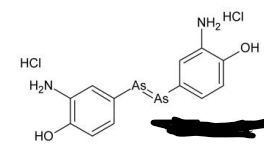
Germicides
Anti-infective agents that are used locally are called __________, and within this classification, there are two primary subtypes and several other definitions of sanitization.
Antiseptics
___________ are compounds that kill (-cidal) or prevent the growth of (-static) microorganisms when applied to living tissue.
1. Low toxicity
2. Exert a rapid and sustained action
3. Low surface tension
4. Retain activity in presence of body fluids
5. Non-irritating to tissues
6. Non-allergenic
7. Does not interfere with healing
Ideal Characteristics of an antiseptic agent (7)
1. Bacitracin
2. Polymyxin
3. silver sulfadiazine
4. Neomycin
A few antibiotics, such as _______, ____________, _______________, and ___________, are poorly absorbed through the skin and mucous membranes and are used topically for the treatment of local infections.
Disinfectant
An agent that prevents transmission of infection by the destruction of pathogenic microorganisms when applied to inanimate objects
1. Exert rapid lethal action to pathogenic microorganisms and spores
2. Good penetrating properties into organic matter
3. Shares compatibility with organic compounds (esp soaps)
4. Not inactivated by living tissues
5. Non corrosive
6. Aesthetically pleasing
6 Characteristics of an ideal Disinfectant
Washing of hands
The most important means of preventing transmission of infectious agents from person to personorfrom regions of high microbial load, such as the mouth, nose, or gut, to potential sites of infection is simply ________________
Skin disinfectants with soap and water
These are usually used as preoperative surgical scrubs and sterilants for surgical incisions.
Chemotherapy
It is the study and the use of chemical agents that are selectively more toxic to invading organisms than to the host.
1. Chemical type
2. Biological property
3. Therapeutic indication
3 Chemotherapeutic agents are classified according to their:
Antibiotics
Anti infectives from natural source to semi-synthetic
Antimicrobials
Anti infectives produced from synthetic substance
Antisepsis
Application of an agent to living tissue to prevent infection
Decontamination
Destruction or marked reduction in the number or activity of microorganisms
Disinfection
The chemical or physical treatment that destroys most vegetative microbes or viruses, but not spores, in or on inanimate surfaces
Sanitization
The reduction of microbial load on an inanimate surface to a level considered acceptable for public health purposes
Sterilization
The process intended to kill or remove all types of microorganisms, including spores, and usually viruses with an acceptably low probability of survival
Pasteurization
A process that kills nonsporulating microorganisms by hot water or steam at 65 to 100 degrees Celsius
Phenol Coefficient test
A standardized test in which the dilution of the chemical agent being evaluated that kills a standard number of bacteria in 10 min is compared to the dilution of phenol that accomplished the same task
Salmonella typhii, and Staphylococcus aureus
Phenol Coefficient test has some faults in that the standard test organisms are ___________________, and _______________ and not the gram-negative bacteria that are usually associated with nosocomial infections.
1. Infections acquired in the hospital
2. An organism can become resistant to disinfectants and in some cases, the disinfectant has become a source of infection for the susceptible person
2 Nosocomial infection
1. Oxidizing agents
2. Dehydrating agents
3. Alkylating agents
4. Sulfhydryl Combining agents
5. Agents affecting permeability
5 Modes of action
1. Halogens (Chlorine and Iodine)
2. Hydrous benzoyl peroxide
3. Acids
Examples of oxidizing agents
Alcohol
Example of dehydrating agent
1. Ethylene oxide
2. Formaldehyde
3. Glutaraldehyde
Examples of Alkylating agents
1. Anionic and Cationic detergents
2. Non-ionic detergents
3. Phenols
4. Chlorhexidine
Examples of agents affecting permeability
KMnO4
Other oxidizing agents, such as ___________, denature proteins in microorganisms through a direct oxidation reaction
Oxidizing agents
These are effective against anaerobic bacteria and can be used in cleansing contaminated wounds.
Elemental iodine (I2)
the oldest germicide still in use today
Iodine Tincture
2% iodine in 50% alcohol with sodium iodide
Lugol’s Solution
AKA Strong iodine solution (5% iodine in water with potassium iodide)
Iodine Solution
2% iodine in water with sodium iodide
Phenylalanyl and Tyrosyl
sulfhydryl groups
Iodine is one of the most effective and useful of the germicides. It acts to inactivate proteins by iodination of aromatic residues (_________ and _________) and oxidation (______ groups).
Iodophors
are complexes of iodine with non-ionic or cationic surfactants (solubilizers); the complex reduce the volatility of I2 and remove its irritant properties, have both bactericidal and fungicidal properties.
Povidone Iodine
This is a charge-transfer complex of iodine with the nonionic surfactant PVP (polyvinylpyrrolidone).
Povidone Iodine
is used as an aqueous solution for presurgical disinfection of the incision site, can also be used to treat infected wounds and damage to the skin, and it is effective for local bacterial and fungal infections
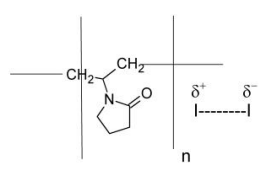
Povidone iodine
Name this compound
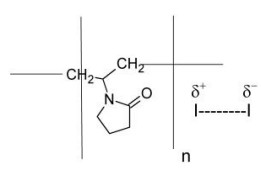
True
True or false?
Povidone iodine is extremely water soluble and releases iodine very slowly
10%
In povidone iodine, approximately ___% of the iodine in the complex is bioavailable.
Chlorine and Chloride releasing compounds
These compounds have been used in the disinfection of water supplies for more than a century.
HClO - Hypochlorous acid
the active germicidal species that is formed when chlorine is dissolved in water led to the development and use of the first inorganic hypochlorite salts such as NaOCl and Ca(OCl)2.
organic N-chloro compounds
Later, __________ were developed as disinfectants. These compounds release hypochlorous acid when dissolved in water, especially in the presence of acid.
Sodium Salt of Halazone
The sodium salt of _________, is used to disinfect drinking water.
Halazone
p-Dichlorosulfamoylbenzoic acid, photosensitive compound with a faint chlorine odor
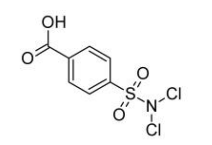
Halazone
Name this compound
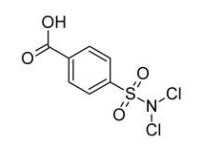
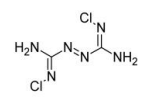
Chloroazodin
Name this compound
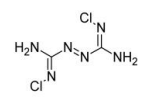
Chloroazodin
N,N-dichlorodicarbonamidine (Azochloramid), yellow crystalline solid with a faint odor of chlorine, unstable to light or heat. It will explode if heated above 155 Celsius
False, the antiseptic action of chloroazodin is long lasting because of its extremely slow reaction with water.
True or False?
The antiseptic action of chloroazodin is fast because of its extremely fast reaction with water.

Oxychlorosene
Name this compound

Oxycholorosene (Chlorpactin)
is a complex of the sodium salt of dodecylbenzenesulfonic acid and hypochlorous acid. The complex slowly releases hypochlorous acid in solution.
Oxycholorosene (Chlorpactin)
The agent has a marked and rapid-cidal action against most microorganisms, including both Gram-positive and Gram-negative bacteria, molds, yeasts, viruses, and spores.
Oxycholorosene (Chlorpactin)
Used to treat localized infections, to remove necrotic tissue from massive infections or radiation necrosis, to counteract odorous discharges, to act as an irritant, and to disinfect cysts and fistulas.
0.1 to 0.5% - Typical Application
0.1 to 0.2% - Urology and Ophthalmology
A typical application uses a ________% concentration in water. Dilutions of _____% are used in urology and ophthalmology.
Hydrous Benzoyl Peroxide (Oxy-5, Oxy-10, Vanoxide)
is a white granular powder. In its pure powder form, it is explosive. The compound is formulated with 30% water to make it safer to handle.
It is used in the treatment of acne
Benzoyl Peroxide
This induces proliferation of epithelial cells, leading to sloughing and repair
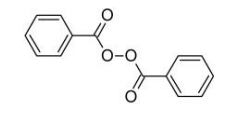
Hydrous Benzoyl Peroxide
Name the compound
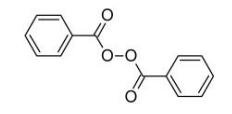
Tinea or ringworm
Dermatophytoses are collectively called
Keratolytic agents - Salicylic acid or other α-hydroxy compounds
The skin is a formidable barrier to drug penetration, and many of the topical agents work best if an adjuvant is added that opens the barrier function of the skin. _____________ such as ___________ or other ________________ perform this function reasonably well.
Sebum
Adults have an acidic, fatty substance in and on the skin called ____________
antifungal
Sebum functions as a natural ______ agent, part of the innate immune system.
Propionic acid
an antifungal agent that is nonirritating and nontoxic. After application, it is present in perspiration in low concentration (0.01%).
Zinc Propionate
Occurs as an anhydrous form and as a monohydrate, salt is unstable to moisture, and is used as a fungicide, particularly on adhesive tape.
Undecylenic acid (Desenex, Cruex)
Obtained from destructive distillation of castor oil. A viscous yellow liquid.
Insoluble in water, but soluble in alcohol and most organic solvents
can be used in concentrations up to 10% in solutions, ointments, powders, and emulsions for topical administrations.
the preparations should never be applied to mucous membranes because it is a severe irritant
Benzoic acid
This possesses appreciable antifungal effects, but it cannot penetrate the outer layer of theskin in infected areas. Therefore, when used as an antifungal agent, this must be admixed with a keratolytic agent.
Whitfield’s Ointment, USP
An old preparation that is still in use is _________________. This ointment contains benzoic acid (6%) and salicylic acid (6%) in a petrolatum base. The cure rates from preparations like these are low.
Salicylic acid - pKa 2.5
is a strong aromatic acid (pKa ____) with both antiseptic and keratolytic properties
occurs as white, needle like crystals or a fluffy crystalline powder, depending on how the compound was brought out of solution.
used externally in ointments and solutions for its antifungal and keratolytic properties.
only slightly soluble in water but is soluble in most organic solvents.
m-Hydroxyphenol (resorcinol)
possesses antiseptic and keratolytic activity. It occurs as white, needlelike crystals and has a slightly sweet taste
is soluble in water, alcohols, and organic solvents.
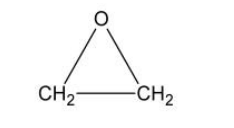
Ethylene Oxide (C2H4O)
Name this compound
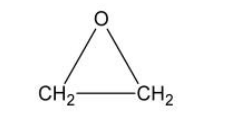
Ethylene Oxide (C2H4O)
has been used to sterilize temperature sensitive medical equipment and certain pharmaceuticals that cannot be heat sterilized in an autoclave.
Ethylene Oxide (C2H4O)
a colorless, flammable gas that liquefies at 12°C
Ethylene Oxide (C2H4O)
readily through porous materials and very effectively destroys all forms of microorganisms at ambient temperatures
Ethylene Oxide (C2H4O)
forms explosives mixtures in air at concentrations ranging from 3% to 80% by volume.
CO2
Mixed to Ethylene oxide to eliminate explosion hazard
Ethylene Oxide
is a nonselective alkylating agent, and for that reason is extremely toxic and potentially carcinogenic.
Formalin
is a colorless aqueous solution that officially contains not less than 37% w/v of formaldehyde(HCHO), with methanol added to retard polymerization
Formic acid, and paraformaldehyde
Formaldehyde readily undergoes oxidation and polymerization, leading to ___________ and _______________, respectively, so the preparation should be stored in tightly closed, light-resistant containers
15 degrees Celsius
Formalin must be stored at temperatures above ______ to prevent cloudiness, which develops at lower temperatures
Action is slow but powerful
The germicidal action of formaldehyde is (slow/fast) but (weak/powerful).
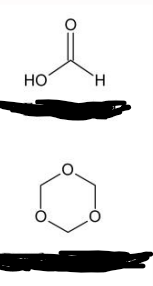
Top - Formic Acid
Bottom - Paraformaldehyde
Name these compounds
